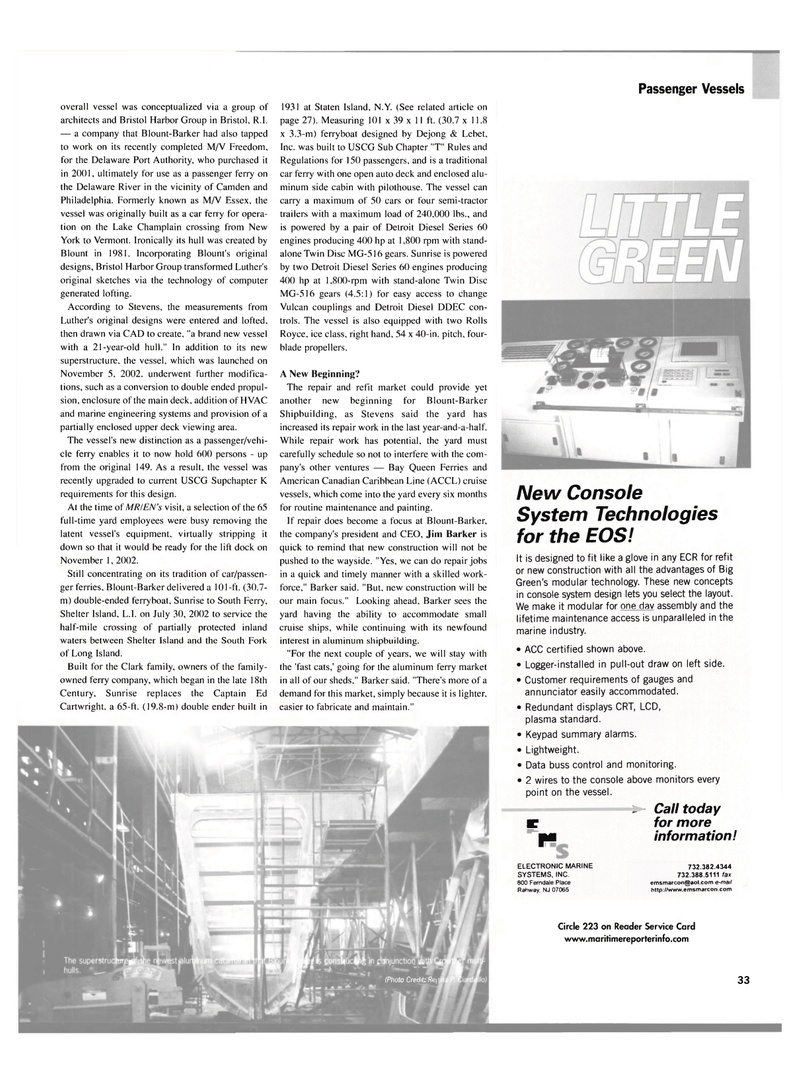
Page 33: of Maritime Reporter Magazine (January 2003)
Read this page in Pdf, Flash or Html5 edition of January 2003 Maritime Reporter Magazine
Passenger Vessels overall vessel was conceptualized via a group of architects and Bristol Harbor Group in Bristol, R.I. — a company that Blount-Barker had also tapped to work on its recently completed M/V Freedom, for the Delaware Port Authority, who purchased it in 2001, ultimately for use as a passenger ferry on the Delaware River in the vicinity of Camden and
Philadelphia. Formerly known as M/V Essex, the vessel was originally built as a car ferry for opera- tion on the Lake Champlain crossing from New
York to Vermont. Ironically its hull was created by
Blount in 1981. Incorporating Blount's original designs, Bristol Harbor Group transformed Luther's original sketches via the technology of computer generated lofting.
According to Stevens, the measurements from
Luther's original designs were entered and lofted, then drawn via CAD to create, "a brand new vessel with a 21-year-old hull." In addition to its new superstructure, the vessel, which was launched on
November 5, 2002. underwent further modifica- tions, such as a conversion to double ended propul- sion, enclosure of the main deck, addition of H VAC and marine engineering systems and provision of a partially enclosed upper deck viewing area.
The vessel's new distinction as a passenger/vehi- cle ferry enables it to now hold 600 persons - up from the original 149. As a result, the vessel was recently upgraded to current USCG Supchapter K requirements for this design.
At the time of MR/EN's visit, a selection of the 65 full-time yard employees were busy removing the latent vessel's equipment, virtually stripping it down so that it would be ready for the lift dock on
November 1, 2002.
Still concentrating on its tradition of car/passen- ger ferries, Blount-Barker delivered a 101 -ft. (30.7- m) double-ended ferryboat, Sunrise to South Ferry,
Shelter Island, L.I. on July 30, 2002 to service the half-mile crossing of partially protected inland waters between Shelter Island and the South Fork of Long Island.
Built for the Clark family, owners of the family- owned ferry company, which began in the late 18th
Century, Sunrise replaces the Captain Ed
Cartwright. a 65-ft. (19.8-rn) double ender built in 1931 at Staten Island, N.Y. (See related article on page 27). Measuring 101 x 39 x 11 ft. (30.7 x 11.8 x 3.3-m) ferryboat designed by Dejong & Lebet,
Inc. was built to USCG Sub Chapter "T" Rules and
Regulations for 150 passengers, and is a traditional car ferry with one open auto deck and enclosed alu- minum side cabin with pilothouse. The vessel can carry a maximum of 50 cars or four semi-tractor trailers with a maximum load of 240.000 lbs., and is powered by a pair of Detroit Diesel Series 60 engines producing 400 hp at 1,800 rpm with stand- alone Twin Disc MG-516 gears. Sunrise is powered by two Detroit Diesel Series 60 engines producing 400 hp at 1,800-rpm with stand-alone Twin Disc
MG-516 gears (4.5:1) for easy access to change
Vulcan couplings and Detroit Diesel DDEC con- trols. The vessel is also equipped with two Rolls
Royce, ice class, right hand, 54 x 40-in. pitch, four- blade propellers.
A New Beginning?
The repair and refit market could provide yet another new beginning for Blount-Barker
Shipbuilding, as Stevens said the yard has increased its repair work in the last year-and-a-half.
While repair work has potential, the yard must carefully schedule so not to interfere with the com- pany's other ventures — Bay Queen Ferries and
American Canadian Caribbean Line (ACCL) cruise vessels, which come into the yard every six months for routine maintenance and painting.
If repair does become a focus at Blount-Barker, the company's president and CEO, Jim Barker is quick to remind that new construction will not be pushed to the wayside. "Yes, we can do repair jobs in a quick and timely manner with a skilled work- force," Barker said. "But, new construction will be our main focus." Looking ahead, Barker sees the yard having the ability to accommodate small cruise ships, while continuing with its newfound interest in aluminum shipbuilding. "For the next couple of years, we will stay with the 'fast cats,' going for the aluminum ferry market in all of our sheds." Barker said. "There's more of a demand for this market, simply because it is lighter, easier to fabricate and maintain."
New Console
System Technologies for the EOS!
It is designed to fit like a glove in any ECR for refit or new construction with all the advantages of Big
Green's modular technology. These new concepts in console system design lets you select the layout.
We make it modular for one day assembly and the lifetime maintenance access is unparalleled in the marine industry. • ACC certified shown above. • Logger-installed in pull-out draw on left side. • Customer requirements of gauges and annunciator easily accommodated. • Redundant displays CRT, LCD, plasma standard. • Keypad summary alarms. • Lightweight. • Data buss control and monitoring. • 2 wires to the console above monitors every point on the vessel. » Call today
E for more jM information!
ELECTRONIC MARINE
SYSTEMS, INC. 800 Femdale Place
Rahway, NJ 07065 732 382.4344 732.388.5111 fax [email protected] e-mail http://www.emsmarcon.com
Circle 223 on Reader Service Card www.maritimereporterinfo.com 33 (Photo Credit: Ret

 32
32

 34
34
